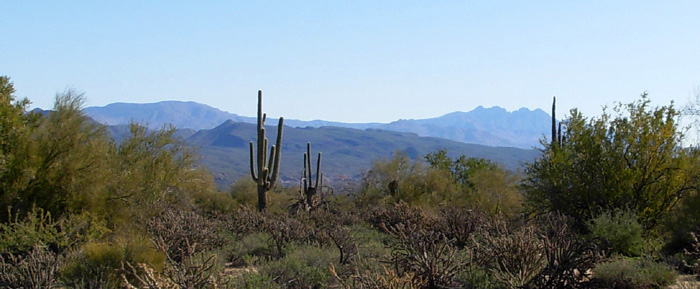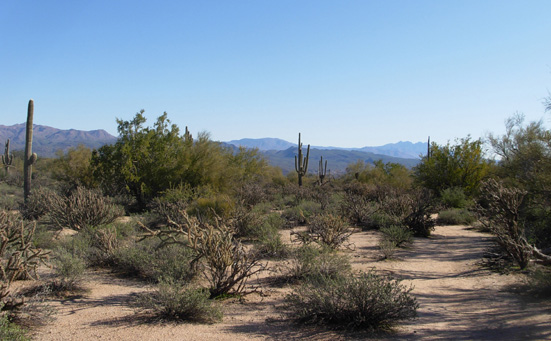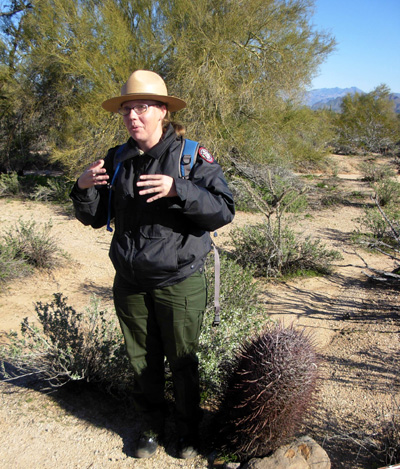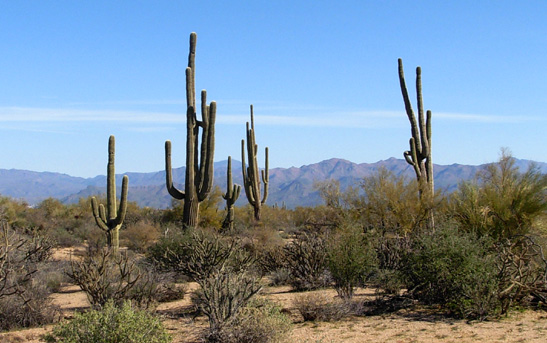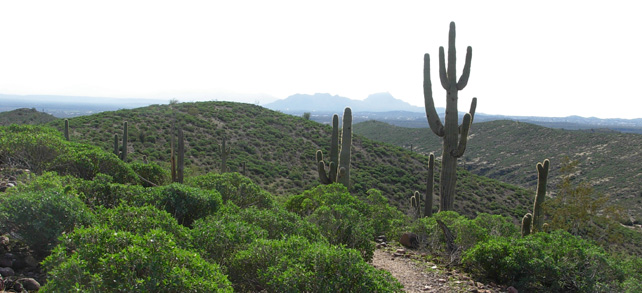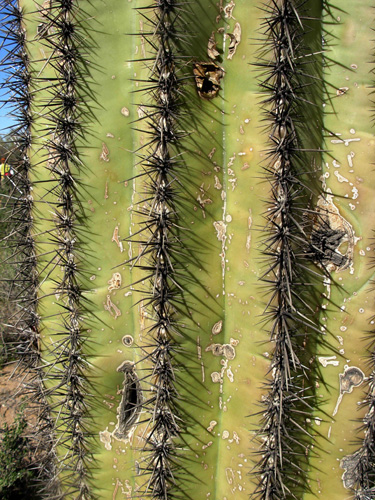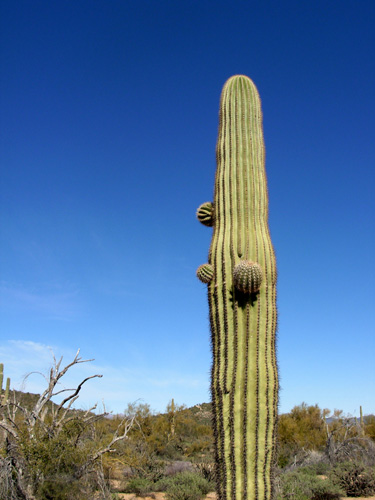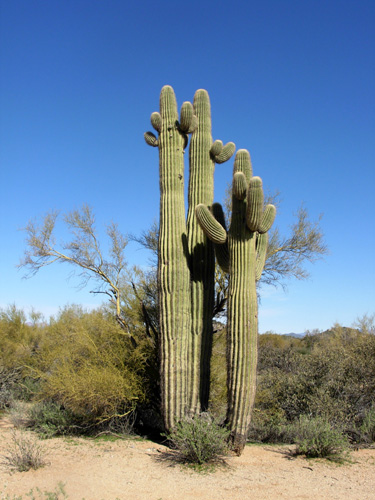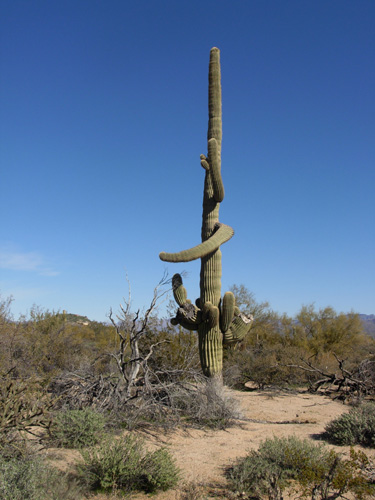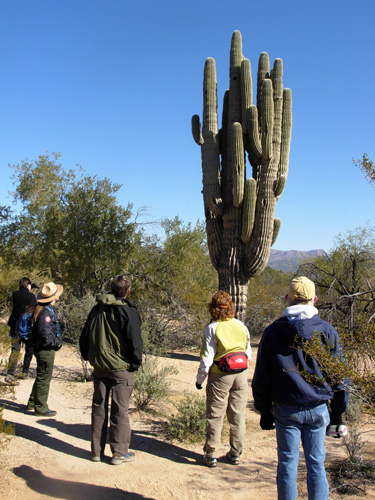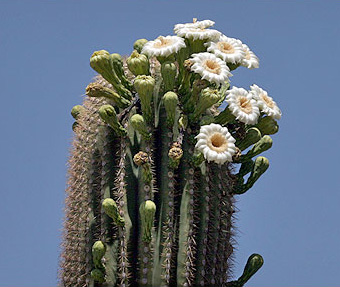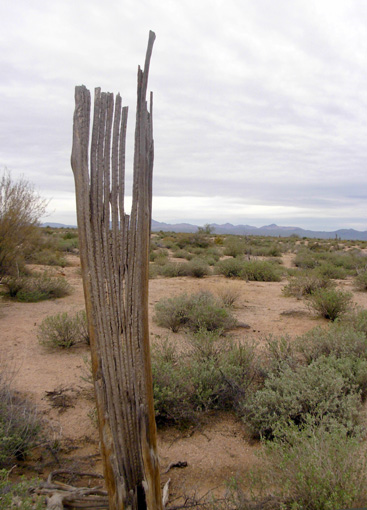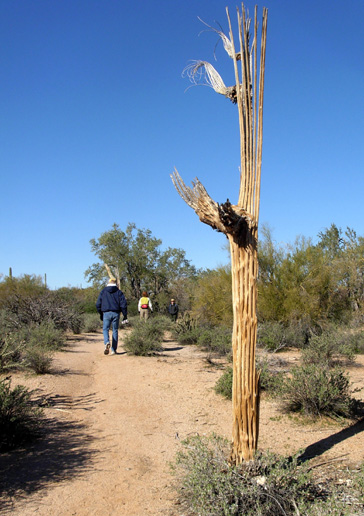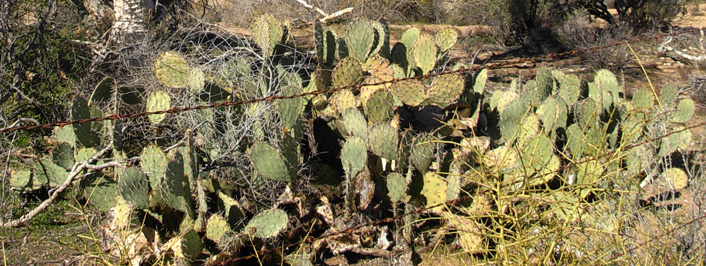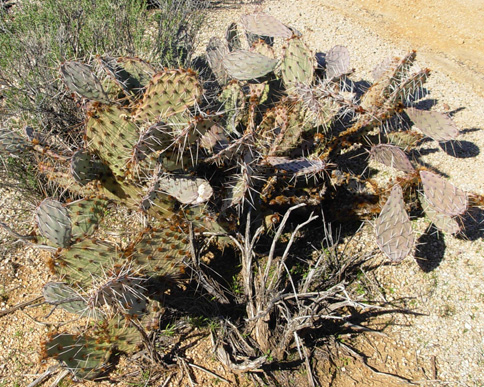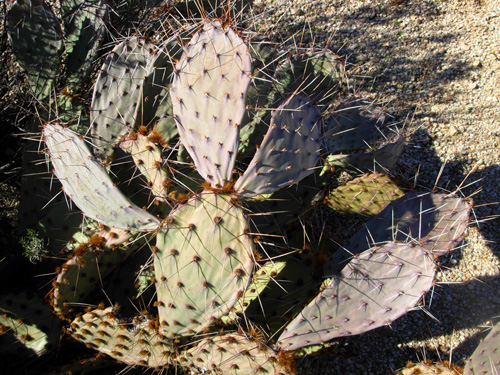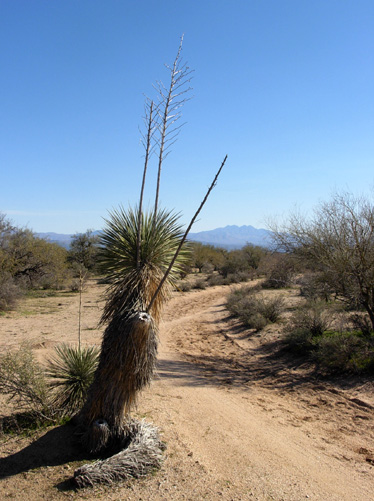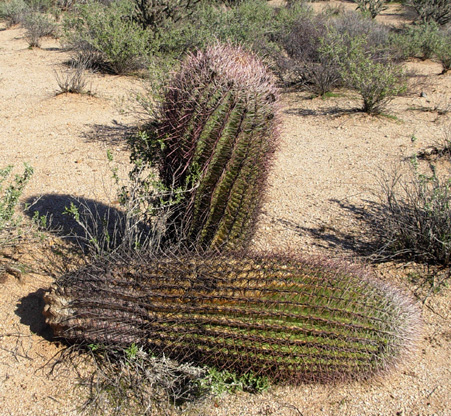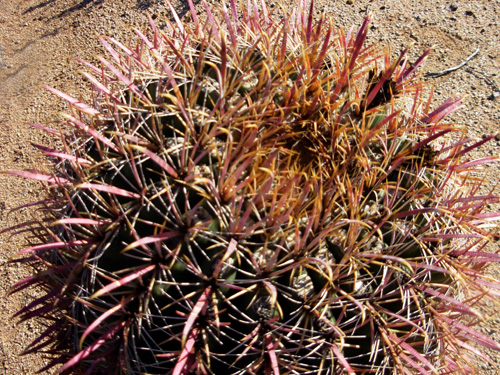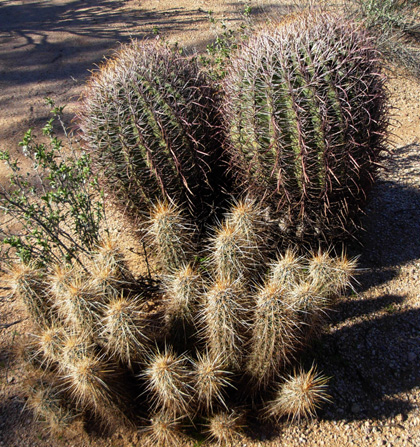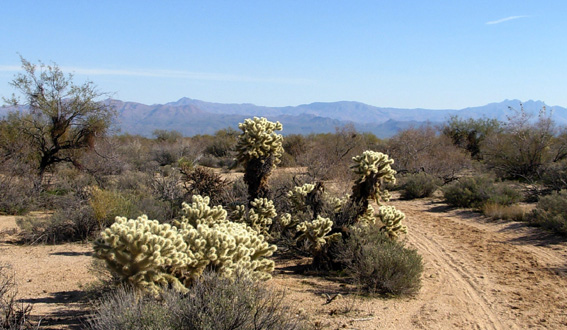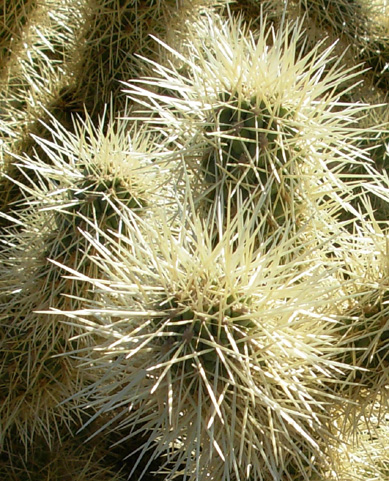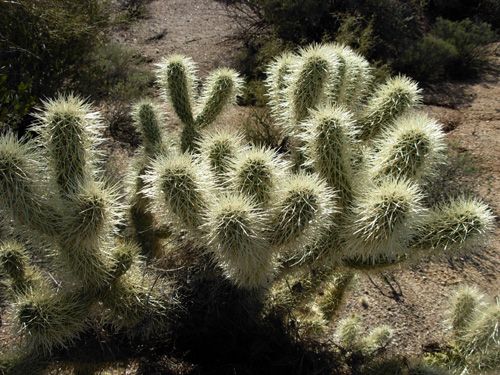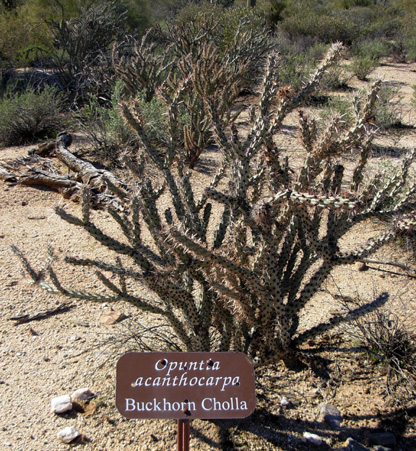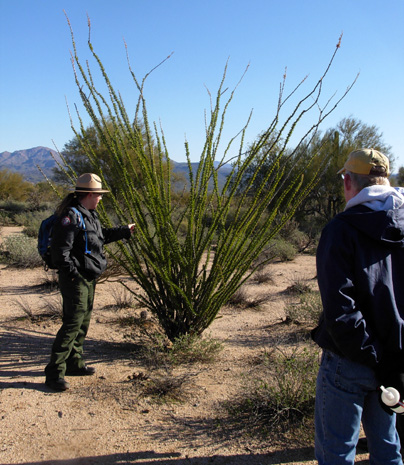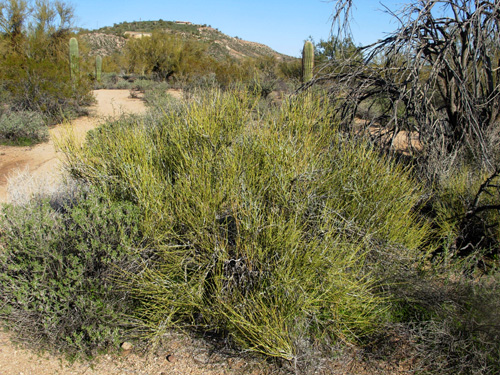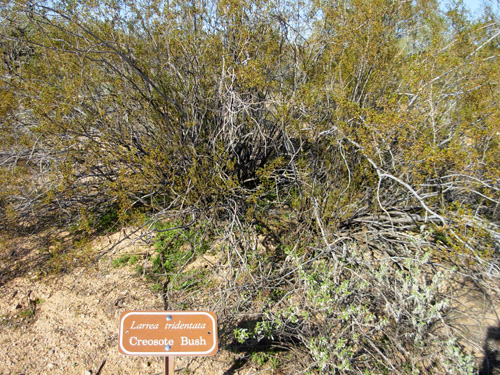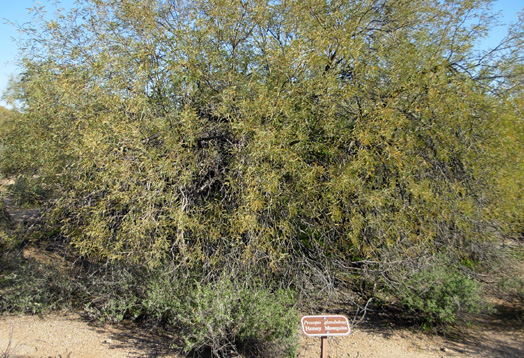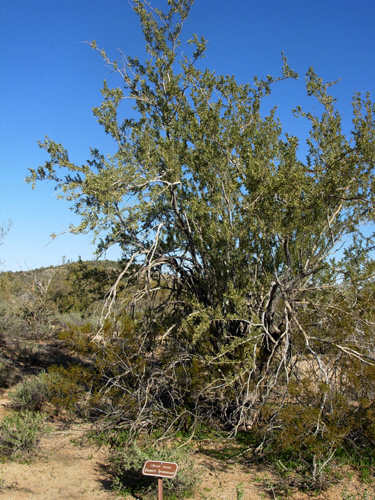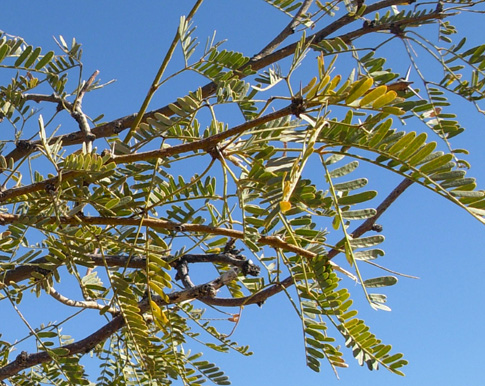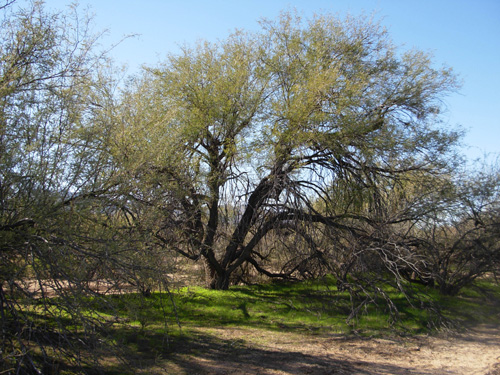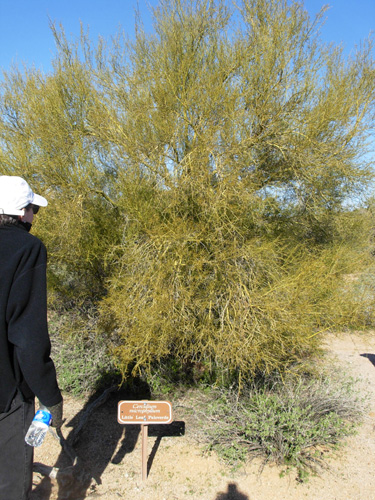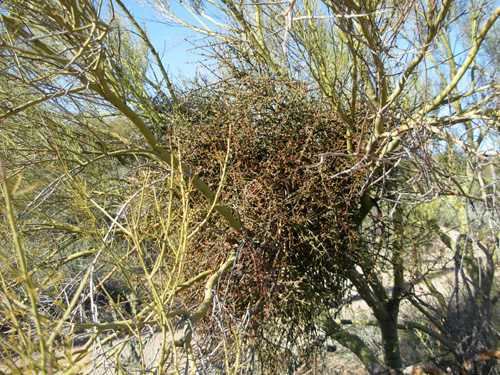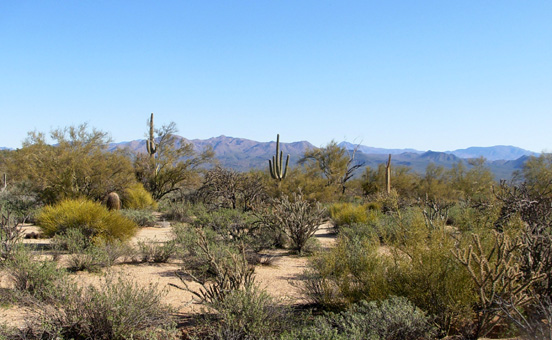|
2008 ULTRA RUNNING ADVENTURES
| ||
|
Runtrails' Web Journal
SUNDAY, JANUARY 20
This desert's power of recovery is nothing short of amazing. We
saw photos in the visitors' center of the destruction from the
Rio Fire but for someone seeing the park the first time, you'd
never know two-thirds of it was a blackened mess thirteen years
ago. In fact, when we first visited McDowell Park in 2004 we
were completely unaware of the fire, which started from a
lightning strike during a dry thunderstorm. Over 500
firefighters from all across the West fought the blaze, which
damaged a total of 20,000 acres (some outside the park) in
110-degree July heat. Click on that first link above for photos
of the destruction.
I especially like the part quoted above about the desert's
"amazing (and inspiring) ability to renew itself."
Maybe we can draw an analogy about the resilience of not only nature,
but also humans, when disasters strike.
NATURE HIKE ON THE NORTH TRAIL
Although we took a ranger-guided hike on the North Trail to
learn more about the flora in the park, each day we were on the
trails was a sensory learning experience about all the plants
around us -- visual, tactile, auditory, olfactory. I'm able to
appreciate nature even more when I know the names of some of the
plants, their growth habits, what their flowers or fruit looks
like, how indigenous peoples used them,
how they provide food or shelter to animals, and so on.
Ranger Emily (photo below) led our hike, which was attended by
about seven people one chilly but sunny January morning. She identified various plants, guessed their
ages, told us about their unique characteristics, described how
the Hohokum Indians used them, and answered all our questions
about desert flora. She also pointed out tracks and scat left by
bobcats, coyotes, deer, javelinas, and jack rabbits and
identified birds we heard or saw during the hike.
In this entry I'll focus on some of the most interesting and
common plants at McDowell Mountain Park. I took some of the
photos during the nature hike and others while on the network of
other trails in the park. Hopefully I'll be able to accurately
match the photos with the notes I took during the guided
nature hike. A lot of the trees and shrubs on North Trail are
identified with signs, so that helps!
When I've had questions about some of the plants at McDowell
that our brochures don't answer I've turned mostly to this
website
http://www.desertusa.com
for information and photos. Fast links to plants and
animals are to the left on the home page.
CACTI & SUCCULENTS AT McDOWELL PARK
KING OF THE HILL: SAGUARO CACTUS
The most ubiquitous, easily-identified plant that is synonymous
with the Sonoran Desert is the Saguaro Cactus (the "g" is
pronounced like a "w" and the "a's" are soft: sa-WA-ro).
I chose the photo at the top of each page in the 2008 journal
because of the distinctive armed cacti silhouetted against
nearby mountains and blue sky. That photo is from the North
Trail. I've got lots of similar photos from other vantage points
in McDowell Park.
This is an excellent description of the plant from the
DesertUSA
website
above (passages in italics). All photos in this entry are ones I took, except
for the flower: The magnificent Saguaro Cactus, the
state flower of Arizona, is composed of a tall, thick, fluted, columnar
stem, 18 to 24 inches in diameter, often with several large branches
(arms) curving upward in the most distinctive conformation of all
Southwestern cacti.
The Saguaro often begins life in the shelter of a "nurse" tree or shrub
which can provide a shaded, moister habitat for the germination of life.
The Saguaro grows very slowly -- perhaps an inch a year -- but to a
great height, 15 to 50 feet. The largest plants, with more than 5 arms,
are estimated to be 200 years old. An average old Saguaro would have 5
arms and be about 30 feet tall . . .
The slow growth and great capacity of the Saguaro to store water allow
it to flower every year, regardless of rainfall. The night-blooming
flowers, about 3 inches wide, have many creamy-white petals around a
tube about 4 inches long. Like most cactus, the buds appear on the
southeastern exposure of stem tips, and flowers may completely encircle
stems in a good year.
When you see the abundance of large, multi-armed Saguaros in
McDowell Park, you wonder how they survived the fire. Yes, there
are a few distinctive skeletons visible from the trails, but
they are scattered randomly throughout the park. Incredible resilience.
Those woody ribs, above, are what gives structure to the tall
cacti. They were used to build the old Pemberton ranch house
that I mentioned in a
recent entry.
I am totally fascinated with Saguaro cacti and in awe of their
age and durability, just as I am in awe of centuries-old trees in old-growth
forests around the country.
Let's check out some other types of cactus here . . .
PRICKLY PEAR CACTUS
In the last entry I mentioned that the preferred food of
javelinas is the Prickly Pear Cactus and I surmised that was the
reason I saw more of the cacti in urban areas than in the park!
This is the equally distinctive flat, round-leaved cactus
depicted along freeway interchanges in nearby Scottsdale, AZ.
You can see a photo I took in the
January 17 entry.
Here are some real ones:
There are about a dozen types of Prickly Pears in the desert
Southwest and similar ones seem to grow lots of places in the
southern half of this country. Some folks who live out our
direction from Roanoke, Virginia even have them in their yards!
(They don't look quite right in such an environment, however --
but who asked for my opinion??)
Prickly Pears come in a variety of colors and range in height
from about one to six feet tall. Here are two types we saw along
the Pemberton Trail in McDowell Mountain Park (above and below).
There are two other photos of Prickly Pear clusters along the
Pemberton Trail in the
January 19 entry.
All Prickly Pears have flat, fleshy pads that resemble thorny leaves.
Photosynthesis occurs here. The pads also store water and
produce flowers and fruit. Again, none of them were in bloom in
January when we visited. Check the
DesertUSA web site for photos
of the plants with fruit and flowers.
YUCCA
Various types of Yucca can also be found across the USA (lots
around Atlanta when I lived there) but they are
most prevalent in the desert areas in the western part of the
country. I saw a few of the Soaptree variety (I think) in McDowell Park,
but not many. This evergreen, palm-like shrub can get up to
eighteen feet tall and has clusters of white, bell-shaped
flowers along the top of its stalk in the spring. In January,
only little bare branches remain on the stalk where the flowers
and seed pods used to be:
The Soaptree Yucca derives its name
from the soapy material in its roots and trunks which made this plant a
popular substitute for soap. Native Americans used the coarse fiber of
the leaves for weaving baskets. Cattle enjoy the tender young stalks,
and chopped trunks and leaves are still utilized as emergency cattle
feed in times of drought. (from the following web page:
http://www.desertusa.com/magfeb98/feb_pap/du_soapyucca.html
) Wikipedia also has some good photos and information about the Soaptree Yucca:
http://en.wikipedia.org/wiki/Soaptree_yucca
BARREL CACTUS
This is another cactus that is easy to identify. There are
several types of Barrel cacti in the southwestern USA and
Mexico. The kind we saw at McDowell Park are Sonora Barrel
Cactus, which are a pretty reddish purple:
Emily told us that Barrel Cactus is nicknamed "Compass Cactus"
because it tends to lean toward the sun.
HEDGEHOG CACTUS
I'll mention this cactus next since the only photo I have of it
is with the larger Barrel Cactus that I just talked about:
The flowers are scarlet or fuschia-colored and cup-shaped. This
cactus is one of the first to bloom in the spring. See
http://www.desertusa.com/mag00/mar/papr/hhog.html.
CHOLLA CACTUS
Another interesting Sonoran cactus species in the Cholla.
There are over twenty kinds of Cholla that have adapted to the
varying terrain, elevations, and temperatures in the American
Southwest. Ranger Emily pointed out several different kinds to
us on our nature walk.
My favorite is the Teddy Bear or "Jumping" Cholla, so named
because it has clusters of barbed spines called glochids
that break off the stems and roll around on the ground like
tumbleweeds.
Cody and I found out one day that the little balls are very
difficult to remove from the skin and the spines hurt like heck.
We were just walking along the road in the campground our second
day in the park when he got one stuck to the side of his foot.
He was in pain but patiently waited for me a couple of minutes
to remove the doggone thing. I was unable to grasp just one tiny
spine to pull it off and it really stung each time I touched the
sharp ends of the thorny ball. I finally had to step on the
thing with my shoe -- and then I had trouble getting it out of
the sole!!
Cody learned very fast to stay in the middle of the trails or
follow r-i-g-h-t b-e-h-i-n-d u-s and not
go wandering off into the desert!
On our nature walk Emily showed us an old packrat nest. The
entrance was cleverly protected by little balls of thorny Cholla
to keep predators away. That's a great example of adaptation and
symbiosis among the organisms that live in this harsh desert
environment.
Despite the "lethal" nature of this plant, I absolutely loved
seeing the Teddy Bears along the trails and roads. They are so
pretty when they're backlit by the sun. They look soft and
fuzzy. As mentioned, they definitely are NOT soft and fuzzy.
Buckhorn and Staghorn Chollas, below, have more slender,
segmented stems than Teddy Bear Chollas. They are hard to
distinguish from each other. Emily pointed out both kinds during
the tour of the North Trail and fortunately some of them had
identification signs:
There are numerous Staghorn and Buckhorn Chollas in the park,
especially in the North Trail loop area. Emily showed us the
fuzzy remains of the edible fruit, which is long gone by
January.
We also saw some Christmas Chollas during our nature walk.
They are more common in the Chihuahuan Desert farther
south.in Arizona, New Mexico, and Texas. I don't have a photo of
Christmas Cholla but you can see what they and other types look
like here:
http://www.desertusa.com/mag99/may/papr/chollas.html
SHRUBS AND TREES AT McDOWELL PARK
OCOTILLO
This shrub appears to be in the cactus family but it isn't.
Narrow, thorny spindles grow up to twenty feet tall and bear
bright red flowers in the spring. After a rain small leaves
appear on the canes (branches) but disappear when the plant gets dry again.
Ranger Emily, shown with Jim in the photo below, explained that
the numerous needles on the branches help to shade the plant to
facilitate water retention.
Native tribes like the Hohokam Indians used the leaves, fruit,
and flowers for medicinal purposes. You can see other photos of
the Ocotillo and its flowers here:
http://www.desertusa.com/nov96/du_ocotillo.html
MORMON TEA
Although this densely-branched green or bluish-green shrub
appears to have no leaves, it does have tiny ones. Male and
female plants bear cone-like flowers. You can make tea
from green or dried branches. Iindigenous peoples have also used the
different varieties of the plant for medicinal purposes for
centuries.
http://www.desertusa.com/april97/du_mormontea.html.
CREOSOTE BUSH
One of the most adaptable and prevalent shrubs in the desert
Southwest, the evergreen Creosote Bush grows up to 10-12 feet tall if it has
plenty of water -- and even wider than that. It's everywhere in McDowell Park, identified by
its waxy, pointed, yellow-green leaves which were used by native
peoples to make antiseptics and emetics. The plant reportedly
emits a musky odor when rainfall releases volatile chemicals in
the leaves but the only time we smelled it was when Emily had us
put our noses to the leaves during our nature walk..
The ranger told us there are some Creosote Bushes in California that
are 12,000 years old, making them the oldest plants on earth.
Amazing. She also showed us the
fuzzy seed capsules on the branches and ground around one of the
shrubs. This link gives directions for starting new plants from
the seeds:
http://www.desertusa.com/creoste.html.
MESQUITE (TREE or SHRUB)
I'm sure glad I took some of these photos with the identifying
signs because the picture of the Honey Mesquite below looks very
similar to the Creosote Bush above -- from a distance. There are
three types of Mesquite. This large shrub or small tree is also
very common in the deserts of the Southwest, including McDowell
Park. Although
the yellowish-green leaves are deciduous, this tree was full of
long, narrow, pointed leaves in mid-January:
Mesquite is quite a useful plant. I took the interesting
information below that is in italics from the
DesertUSA page about the plant: All 3 [varieties of Mesquite]
are deciduous and have characteristic bean pods which have long been
used by humans, wildlife and livestock as a food source. It is estimated
that over 75% of a Coyote's diet in late summer is mesquite beans. Native Americans relied on the mesquite pod
as a dietary staple from which they made tea, syrup and a ground meal called
pinole. They also used used the bark for basketry, fabrics and medicine. A
favorite of bees and other insects, mesquite flowers produce a fragrant honey. The taproots, which can be larger than the
trunk, are often dug up for firewood. Next to Ironwood, mesquite is the best
firewood of the desert, because it burns slowly and is smokeless. The wood is
also used for fence posts, tool handles and to create aromatic charcoal for
barbecuing.
IRONWOOD TREE
I had to find another
source for additional
information about the unique Ironwood tree, which Ranger Emily
told us has wood so dense that it sinks in water. There are
additional links on the web page regarding the cultural and
ecological value of the tree.
Here is a photo of a small Ironwood Tree on our nature hike
along the North Trail:
Ironwood grows only in the Sonoran Desert at altitudes below
2,500 feet. Like the human sunbirds who flock to the desert each
winter, Ironwood doesn't like to get too cold! This large species,
which can reach heights of 45 feet tall, can also live up to
1,500 years. Wow.
Ironwoods have bluish-green compound leaves that are almost
fern-like. Purplish or white flowers bloom in the spring, and
brown, hairy pods with edible seeds appear in July.
The cool, shaded microclimate in, under, and around Ironwood
trees provides an important ecological biodiversity in the hot
desert. This quote comes from the Pima County
website link above, which has
more interesting information about Ironwoods than you'd believe
is possible! "By keeping ancient ironwoods alive, we maintain the oldest
medicine show, native wildlife menagerie and migratory pollinator
bed-and-breakfast in town. These hardy old trees provide ideal habitat
for everything from night-blooming cacti to tree lizards, desert bighorn
and cactus owls. The list of residents living under a 45-foot ironwood
reads like the Who's Who of the Sonoran Desert." -
Gary Nabhan Here's my photo (again) of a magnificent old Ironwood on the
Pemberton Trail:
The web page goes on to say that more than 230 plant species have been
recorded starting their growth within the protective microclimate under
Ironwood "nurse plants." "This also creates an optimum wildflower nursery
which is foraged by rabbits, bighorn, and other native species . . . In
addition to the birds [150 species], there are 62 reptiles and amphibians, and
64 mammals that use Ironwoods for forage, cover and birthing grounds."
Double wow. That's almost as impressive to me as the ripe old
age they can attain.
LITTLE LEAF or FOOTHILL PALOVERDE
I learned to distinguish Foothill Paloverde trees by their smooth,
yellowish-green green trunks and branches. "Palo verde" is
Spanish for "green wood" or "green stick." The Foothill variety
(in the photo below) reaches about twenty feet. The other common
variety has bluish leaves and stems and gets twice as tall. I
didn't notice any of the blue ones at McDowell but there may be
some there..
The Foothill Paloverde is another long-lived tree, capable of
living up to 400 years. The tree can photosynthesize through its
green bark, which is unusual. The tree can drop leaves to combat
heat and branches to protect itself in a bad drought. In the spring the tree is
briefly covered in masses of yellow flowers. You can see a photo
of the flowers and learn more about Paloverdes here:
http://www.desertusa.com/mag01/aug/papr/palov.html
DESERT MISTLETOE
My photo of Christmas Cactus didn't turn out well so I just
deleted it and didn't even talk about THAT plant above . . .
but in the holiday spirit, here's some Desert Mistletoe! I
don't know if you can use it to garner kisses like the usual
kind of mistletoe hung up at Christmas-time. I suppose you could if
you live in the desert Southwest.
I doubt any of us on the nature hike would have noticed the
tangled partial-parasite in the Paloverde tree above if Ranger Emily
hadn't pointed it out to us. It has pinkish-coral berries
during the winter and scented flowers in the spring.
http://www.saguaro-juniper.com/i_and_i/trees&shrubs/mistletoe/mistletoe.html
OTHER TREES AND SHRUBS
There are many more types of trees and shrubs that have adapted
well to life in the Sonoran Desert, including McDowell Mountain
Regional Park. I haven't mentioned common ones like Agave,
Brittlebush, and Jojoba simply because of lack of space -- and
photos! I've included links from three or four good web
references in this entry, and you can find many more by doing an
internet search. These sites have additional links to
follow for further information, if you're botanically inclined.
The best places at McDowell Park to learn about the flora and
fauna are at the visitors' center and the three-mile North
Trail, where many of the plants are identified. We didn't do our
ranger-guided hike until January 17, four days before leaving
the park. Our runs and hikes would have been even more interesting if we'd
had more information about the plants from the beginning of our
visit.
The winter months are
great to run, hike, ride, or camp in the
Sonoran Desert, with lots of bright sunshine and pleasant daytime
temperatures. We really enjoyed seeing the variety of plants
during their dormant season. Spring would be even more interesting,
however, when the
cacti and wildflowers are in bloom. I hope we can be here
sometime to see the show in March and April.
Next entry: we're off to New Mexico tomorrow - come visit
the beautiful White Sands area with us! We'll still be in
desert terrain but at higher elevations.
Happy trails,
Sue
© 2008 Sue Norwood and Jim O'Neil |
|||
